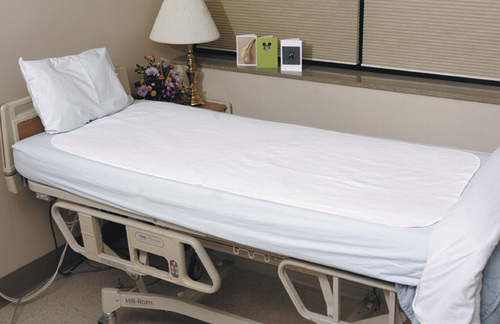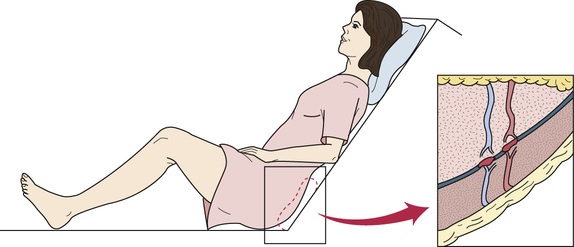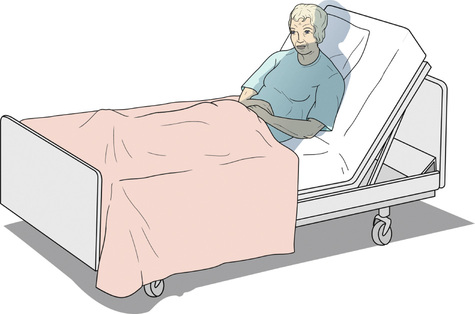Safely Moving the Person
Objectives
• Define the key terms and key abbreviation in this chapter.
• Identify comfort and safety measures for moving the person.
• Explain how to prevent work-related injuries when moving persons.
• Describe 5 functional status levels for bed mobility.
• Identify the delegation information needed before moving the person.
• Perform the procedures described in this chapter.
• Explain how to promote PRIDE in the person, the family, and yourself.
Key Terms
Key Abbreviation
| ID | Identification |
You will move persons often. You assist with bed mobility. The Centers for Medicare & Medicaid Services (CMS) defines bed mobility as how a person moves to and from a lying position, turns from side to side, and re-positions in a bed or other furniture. You also position persons in chairs and wheelchairs. You must work carefully to protect yourself and the person from injury.
See Focus on Communication: Safely Moving the Person.
See Promoting Safety and Comfort: Safely Moving the Person.
Preventing Work-Related Injuries
Moving procedures involve lifting, awkward postures, and repeated motions. These place you at increased risk for injury. You must prevent work-related injuries during moving procedures. See Chapter 17.
Good body mechanics alone will not prevent injury. The Occupational Safety and Health Administration (OSHA) recommends:
Each person is different. Careful planning is needed to move the person safely. You must know:
• The person’s functional status. Functional status is the person’s ability to perform the activities of daily living (ADL) required to meet basic needs and required for health and well-being. Some persons move without help. Others depend on the staff. Know the person’s functional status before you move a person. See Box 18-1. Tell the nurse about changes in the person’s abilities.
• What procedure to use. The nurse and care plan tell you what procedure to use.
See Focus on Children and Older Persons: Preventing Work-Related Injuries.
See Teamwork and Time Management: Preventing Work-Related Injuries, p. 264.
See Delegation Guidelines: Preventing Work-Related Injuries, p. 264.
See Promoting Safety and Comfort: Preventing Work-Related Injuries, p. 264.
Protecting the Skin
Protect the person’s skin during moving procedures. Friction and shearing injure the skin. Both cause infection and pressure ulcers (Chapter 37).
• Friction is the rubbing of 1 surface against another. When moved in bed, the person’s skin rubs against the sheet.
• Shearing is when the skin sticks to a surface while muscles slide in the direction the body is moving (Fig. 18-1). It occurs when the person slides down in bed or is moved in bed.
To reduce friction and shearing when moving the person in bed:
• Use friction-reducing devices. Such devices include a lift sheet (turning sheet). Drawsheets (Chapter 21) serve as lift sheets (turning sheets). Turning pads (Fig. 18-2), large re-usable waterproof under-pads (Chapter 21), and slide sheets (p. 269) are other friction-reducing devices.

See Focus on Children and Older Persons: Protecting the Skin.
See Focus on Surveys: Protecting the Skin.
Moving Persons in Bed
Some persons can move and turn in bed. Others need help from at least 1 person. Those who are weak, unconscious, paralyzed, or in casts need help. Sometimes 2 or 3 people or a mechanical lift (Chapter 19) is needed. Follow the guidelines in Box 18-2 when lifting or moving persons in bed.
See Focus on Communication: Moving Persons in Bed.
See Delegation Guidelines: Moving Persons in Bed, p. 266.
 Raising the Person’s Head and Shoulders
Raising the Person’s Head and Shoulders
Sometimes you raise the person’s head and shoulders to give care. Simply turning or removing a pillow requires this procedure. You can raise the person’s head and shoulders easily and safely by locking arms with the person. Do not pull on the person’s arm or shoulder. Have help with older persons and with those who are heavy or hard to move. This protects the person and you from injury.
See procedure: Raising the Person’s Head and Shoulders.
 Moving the Person Up in Bed
Moving the Person Up in Bed
When the head of the bed is raised, it is easy to slide down toward the middle and foot of the bed (Fig. 18-5). You move the person up in bed for good alignment and comfort.
You can sometimes move light-weight adults up in bed alone if they assist using a trapeze. However, it is best done with help and an assist device (p. 269). For heavy, weak, and older persons, 2 or more staff members are needed. Always protect the person and yourself from injury.
See Promoting Safety and Comfort: Moving the Person Up in Bed, p. 268.
See procedure: Moving the Person Up in Bed, p. 268.









